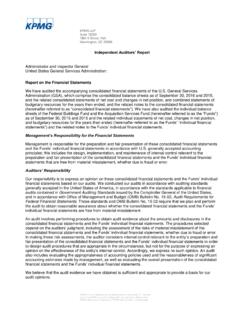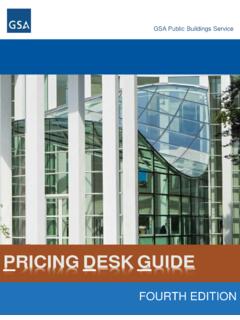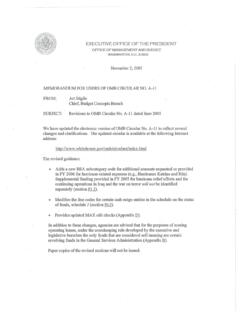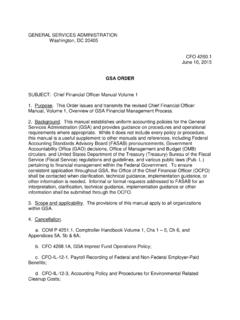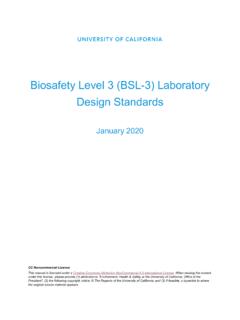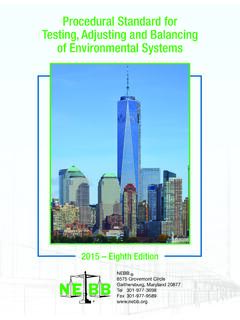Transcription of Fire Protection & Life Safety
1 123456789 AFire Protection & Life Safety 7 ATF National laboratory Center and Fire Research laboratory Architect: Kallmann McKinnell & Wood Architects, Inc. Beltsville, Maryland GSA Project Manager: John L. Crowley TABLE OF CONTENTS General Approach 211 Scope 211 Applicability Certificate of Occupancy Fire Safety During Construction and Renovation Projects Commissioning Building Construction Interior Finishes Occupancy Classifications Means of Egress 218 Photoluminescent Materials Fire Alarm Systems 219 Manual Fire Alarm Boxes 220 Waterflow Switches 220 Smoke Detectors 220 Audible Notification Appliances 220 Visible Notification Appliances 221 Fire Alarm Messages for High Rise Occupancies 222 Survivability 222 Fire Command Center Water Supply for Fire Protection Non-Water Based Fire Extinguishing Systems 224 Sprinkler system Design 224 Types of Sprinklers 225 Sprinkler Piping system 225 Automatic Sprinkler Systems for Remote/Isolated Facilities Non-Water Based Fire Extinguishing Systems Standpipes and Fire
2 Department Hose Outlets Portable Fire Extinguishers and Cabinets Fire Protection for Storage Facilities 227 Archive and Record Center Special Fire Protection Requirements 228 Elevator Systems 228 Electrical Equipment Rooms and Electrical Closets 228 Essential Electronic Facilities 229 Places of Confinement 229 Atriums 229 Track Files 230 Cooling Towers 230 Residential Housing Units 230 Chemical Laboratories 231 Court Facilities 231 Marshal Service 231 Land Port of Entry Facilities 231 Child Care Center Emergency Power, Lighting and Exit Signage Historic Structures 21 0 FACILITIES STANDARDS FOR THE PUBLIC BUILDINGS SERVICE 7. 0 Table of Contents Revised March 2005 PBS-P100 General Approach GSA s approach in the construction of new facilities and projects in existing facilities is to incorporate efficient, cost-effective fire Protection and life Safety systems that are effective in detecting, extinguishing or controlling a fire event that results in improving overall building Safety .
3 The primary goal is to protect human life from fire and products of combustion. The secondary goals are to reduce the potential loss from fire ( , Federal real and personal property, maintain client agency mission continuity, and control environmental impact) to the Federal Government and taxpayer. Scope This chapter provides the technical fire Protection and life Safety requirements and design criteria for GSA facilities to meet the goals identified above. The majority of the fire Protection and life Safety requirements are contained in numerous national codes and standards. Compliance with national codes and standards is explained, and areas where GSA s requirements differ from the referenced national codes and standards are delineated. The Authority Having Jurisdiction (AHJ), for all technical requirements in this chapter, for all fire Protection and life Safety code interpretations and code enforcement requirements is the GSA regional fire Protection engineer.
4 Applicability The technical fire Protection and life Safety requirements are primarily directed to the construction of new facilities and renovation projects. However, for renovation projects where the work area consists of a portion or portions of a building, the requirements herein shall be limited to the work area(s) in which work is being performed, unless when specified by the GSA regional fire Protection engineer that the requirements shall also apply throughout the floor on which the work area(s) are located or otherwise beyond the work area. Performance based designs are also encouraged. A registered fire Protection engineer is required to be a full participant of the architect/engineer (A/E) design team for each phase of the project from concepts through design, construction, final acceptance, and occupancy. The design team fire Protection engineer must have at least 6 years experience from which at least 3 consecutive years are directly involved in the fire Protection engineering field.
5 This same or an equally competent professional must remain on the A/E s project staff for each phase of the project and shall perform the following: Analyses and provides criteria for the following: Building Construction Occupancy Classification Means of Egress Fire Alarm system Water Based Fire Extinguishing system (s) Non-Water Based Fire Extinguishing system (s) Smoke control system (s) Calculations for the following: Egress Water Supply Smoke control (Fire Dynamics)/Timed Egress Audibility for Fire Alarm system FIRE PR O TECTION & LIFE S AFE TY 211 Revised March 2005 PBS-P100 General Approach F A CILI TIES S T AND ARDS FOR THE PUBLIC BUILDINGS SER VICE Certificate of Occupancy Revised March 2005 PBS-P100 Design of all fire Protection and life Safety systems including but not limited to: Fire Alarm system Water Based Fire Extinguishing system (s) Smoke control Systems/Stair pressurization Systems See Appendix A for specific submission requirements.
6 For all projects involving fire Protection and life Safety issues, a dialog must be established between the design team fire Protection engineer and the GSA regional fire Protection engineer. The GSA regional fire Protection engineer shall have the right to revise the specific requirements within this chapter based on a technical evaluation/analysis and the project s specific needs. In addition, the Design Team s registered fire Protection engineer may propose alternative designs, systems, methods, or devices not specifically prescribed within this Chapter or in lieu of the specific prescribed requirements within this Chapter. The GSA regional fire Protection engineer shall review the technical documentation submitted by the Design Team s registered fire Protection engineer to determine if the proposed alternative is deemed equivalent or superior to the intent of the prescribed requirements in this chapter. If the GSA regional fire Protection engineer determines that the proposed alternative is deemed equivalent or superior to the intent of the prescribed requirements in this chapter, then the proposed alternative is considered approved by GSA for the purposes of this Chapter and for the application for which the proposed alternative will be used.
7 Refer to Chapter 1 for additional information. 212 7. 2 Certificate of Occupancy No new construction or renovation project or portion thereof shall be occupied until the regional fire Protection engineer has issued a certificate of occupancy to the GSA Project Manager. Issuance of a certificate of occupancy shall not be construed as an approval of any violation of a Code or GSA design standard or criteria. Once the GSA regional fire Protection engineer has ensured that to the best of their knowledge all fire Protection and life Safety systems have been completed, inspected, successfully tested and approved and all outstanding fire and life Safety deficiencies have been corrected to afford a reasonable degree of Safety to the building occupants from fire and similar emergencies, a certificate of occupancy will be issued to the GSA Project Manager. The GSA regional fire Protection engineer is authorized to issue a temporary certificate of occupancy. This certificate shall allow partial occupancy of specific areas, prior to completion of the project.
8 All life Safety and fire Protection systems serving the areas proposed for occupancy and all floors below shall be completed, inspected, successfully tested and approved by the GSA regional fire Protection engineer. The temporary certificate of occupancy shall identify the specific area(s) of the project where occupancy is permitted. Following the issuance of a temporary certificate of occupancy, the GSA regional fire Protection engineer shall set a time frame for the completion, inspection, testing and approval of all life Safety and fire Protection systems, and the correction of any outstanding life Safety and fire Protection deficiencies. Upon completion, inspection, successful testing and approval of all fire Protection and life Safety systems and correction of all outstanding fire and life Safety deficiencies, the GSA regional fire Protection engineer will issue a certificate of occupancy to the GSA Project Manager. FIRE PR O TECTION & LIFE S AFE TY Revised March 2005 PBS-P100 Fire Safety During Construction and Renovations/Commissioning Fire Safety During Construction and Renovation Projects General.
9 Fire Safety during construction and renovation projects shall comply with the requirements in the International Building Code (IBC), International Fire Code (IFC), and National Fire Protection Association (NFPA) 241. Fire Protection Systems. Disruptions to fire alarm and sprinkler systems shall be kept to a minimum or avoided. Delineate phasing of construction to ensure that installations of new systems are expedited, and existing systems are kept in service until the replacement system is operational. If fire Protection systems are to be disrupted, procedures shall be incorporated into the design to maintain equivalent levels of fire Protection and provide formal notification to the facility while systems are down. The GSA regional fire Protection engineer shall make the final determination of the adequacy of proposed equivalent levels of fire Protection prior to the disruption of any fire Protection system . For example, the provision of a 24 hour fire watch by qualified individuals may provide an equivalent level of fire Protection during system disruption in some circumstances.
10 Commissioning The commissioning process will ensure that the fire Protection and life Safety systems and equipment installed in a building are in compliance with the building design requirements. The Design Team s fire Protection engineer shall prepare written commissioning plan documentation that outline the procedures, methods and documentation for each phase of the commissioning process for all types of active and passive fire Protection and life Safety systems from concept through construction, final acceptance, occupancy, and post occupancy. At a minimum, the commissioning plan documentation shall include a discussion on the building structure; applicable standards, federal laws and regulations; system and equipment performance assumptions, codes and standards strategies; testing and start-up requirements; inspection, testing and maintenance requirements; and safeguards to verify and confirm that systems, equipment and devices have undergone start-up testing prior to final acceptance testing, including the identification and notification of all parties needed to perform and witness all testing.
